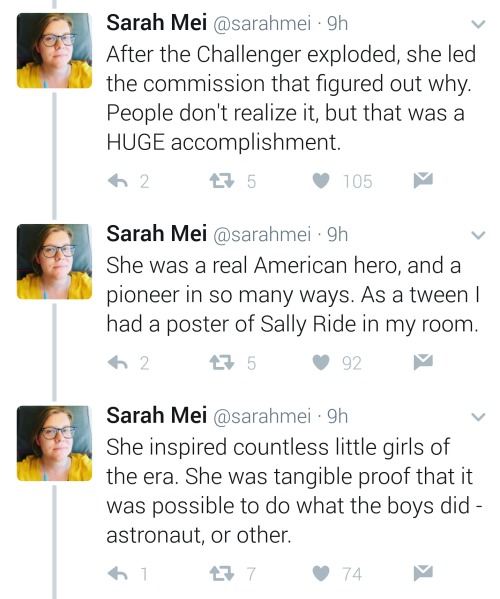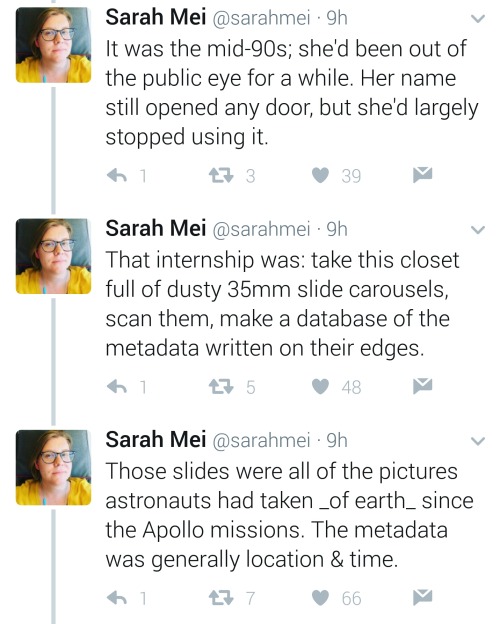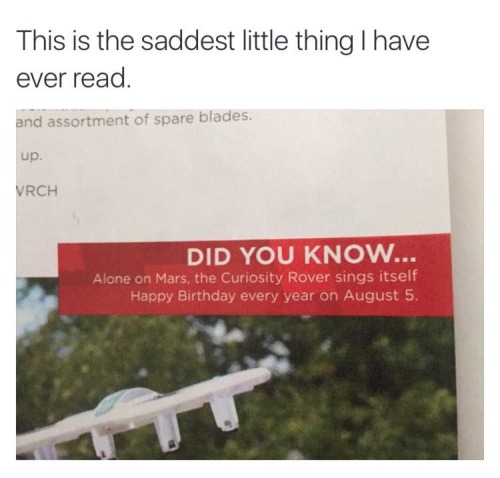Equal Opportunity Benefits Can Be Far-reaching










Equal opportunity benefits can be far-reaching
https://twitter.com/sarahmei/status/818682610712866817
More Posts from Stubborn-turtle-blog and Others
Could be nothing, could be a really bad something

The first worry I have follows from one of the five principles of robotics, which states: robots should not be designed in a deceptive way to exploit vulnerable users; instead their machine nature should be transparent.
To design a gendered robot is a deception. Robots cannot have a gender in any meaningful sense. To impose a gender on a robot, either by design of its outward appearance, or programming some gender stereotypical behaviour, cannot be for reasons other than deception – to make humans believe that the robot has gender, or gender specific characteristics.
When we drafted our 4th ethical principle the vulnerable people we had in mind were children, the elderly or disabled. We were concerned that naive robot users may come to believe that the robot interacting with them (caring for them perhaps) is a real person, and that the care the robot is expressing for them is real. Or that an unscrupulous robot manufacture exploits that belief. But when it comes to gender we are all vulnerable. Whether we like it or not, we all react to gender cues. So whether deliberately designed to do so or not, a gendered robot will trigger reactions that a non-gendered robot will not.
Our 4th principle states that a robot’s machine nature should be transparent. But for gendered robots that principle doesn’t go far enough. Gender cues are so powerful that even very transparently machine-like robots with a female body shape, for instance, will provoke a gender-cued response.
My second concern leads from an ethical problem that I’ve written and talked about before: the brain-body mismatch problem. I’ve argued that we shouldn’t be building android robots at all until we can embed an AI into those robots that matches their appearance. Why? Because our reactions to a robot are strongly influenced by its appearance. If it looks human then we, not unreasonably, expect it to behave like a human. But a robot not much smarter than a washing machine cannot behave like a human. Ok, you might say, if and when we can build robots with human-equivalent intelligence, would I be ok with that? Yes, provided they are androgynous.
My third – and perhaps most serious concern – is about sexism. By building gendered robots there is a huge danger of transferring one of the evils of human culture: sexism, into the artificial realm. By gendering and especially sexualising robots we surely objectify. But how can you objectify an object, you might say? The problem is that a sexualised robot is no longer just an object, because of what it represents. The routine objectification of women (or men) because of ubiquitous sexualised robots will surely only deepen the already acute problem of the objectification of real women and girls. (Of course if humanity were to grow up and cure itself of the cancer of sexism, then this concern would disappear.)
What of the far future? Given that gender is a social construct then a society of robots existing alongside humans might invent gender for themselves. Perhaps nothing like male and female at all. Now that would be interesting.
Alan Winfield is Professor in robotics at UWE Bristol. He communicates about science on his personal blog… read more
More Than Just Drawings
Artist and graphic designer Mike Okuda may not be a household name, but you’re more familiar with his work than you know. Okuda’s artistic vision has left a mark here at NASA and on Star Trek. The series debuted 50 years ago in September 1966 and the distinctive lines and shapes of logos and ships that he created have etched their way into the minds of fans and inspired many.
Flight Ops

The Flight Operations patch has a lengthy history, the original version of which dates to the early 1970s. Having designed a version of the patch, Okuda had some insights about the evolution of the design.
“The original version of that emblem was designed around 1972 by Robert McCall and represented Mission Control. It later changed to Mission Operations. I did the 2004 version, incorporating the space station, and reflecting the long-term goals of returning to the Moon, then on to Mars and beyond. I later did a version intended to reflect the new generation of spacecraft that are succeeding the shuttle, and most recently the 2014 version reflecting the merger of Mission Operations with the Astronaut Office under the new banner Flight Operations.”
“The NASA logos and patches are an important part of NASA culture,” Okuda said. “They create a team identity and they focus pride on a mission.”

In July 2009, Okuda received the NASA Exceptional Public Service Medal, which is awarded to those who are not government employees, but have made exceptional contributions to NASA’s mission. Above, Okuda holds one of the mission patches he designed, this one for STS-125, the final servicing mission to the Hubble Space Telescope.
Orion

Among the other patches that Okuda has designed for us, it one for the Orion crew exploration vehicle. Orion is an integral of our Journey to Mars and is an advanced spacecraft that will take our astronauts deeper into the solar system than ever before.
Okuda’s vision of space can be seen in the Star Trek series through his futuristic set designs, a vision that came from his childhood fascination with the space program.
Learn more about Star Trek and NASA.
Make sure to follow us on Tumblr for your regular dose of space: http://nasa.tumblr.com

Whoah

Wow.
The move to effectively kill the Office of Congressional Ethics was not made public until late Monday, when Representative Robert W. Goodlatte, Republican of Virginia and chairman of the House Judiciary Committee, announced that the House Republican Conference had approved the change. There was no advance notice or debate on the measure.
The surprising vote came on the eve of the start of a new session of Congress, where emboldened Republicans are ready to push an ambitious agenda on everything from health care to infrastructure, issues that will be the subject of intense lobbying from corporate interests. The House Republicans’ move would take away both power and independence from an investigative body, and give lawmakers more control over internal inquiries.
It also came on the eve of a historic shift in power in Washington, where Republicans control both houses of Congress and where a wealthy businessman with myriad potential conflicts of interest is preparing to move into the White House.
[…]
“This is huge,” said Mr. Morgan, who now defends lawmakers targeted in ethics investigations. “It effectively allows the committee to shut down any independent investigation into member misconduct.“
Biomimicry in action to aid robots in walking
(via https://www.youtube.com/watch?v=0ZBD2tcKOU4)

Thousands of scientists in Germany, Peru and Taiwan are preparing for a new year without online access to journals from the Dutch publishing giant Elsevier. Contract negotiations in both Germany and Taiwan broke down in December, while Peru’s government has cut off funding for a licence.
“It’s very unpleasant,” says Horst Hippler, spokesperson for the DEAL consortium of state-funded universities and research organizations, which is overseeing negotiations in Germany. “But we just cannot accept what Elsevier has proposed so far.”
Continue Reading.
We can build things by growing plants in specific configurations now. We are slowly becoming elves.
-
 trashmeowcan liked this · 1 week ago
trashmeowcan liked this · 1 week ago -
 vully-the-vulpix liked this · 2 weeks ago
vully-the-vulpix liked this · 2 weeks ago -
 merry-mouse reblogged this · 2 weeks ago
merry-mouse reblogged this · 2 weeks ago -
 excessive-evidence reblogged this · 2 weeks ago
excessive-evidence reblogged this · 2 weeks ago -
 neuroatypicalcoelacanth reblogged this · 3 weeks ago
neuroatypicalcoelacanth reblogged this · 3 weeks ago -
 cooingbird-org liked this · 1 month ago
cooingbird-org liked this · 1 month ago -
 bundle-of-glitter reblogged this · 1 month ago
bundle-of-glitter reblogged this · 1 month ago -
 bundle-of-glitter liked this · 1 month ago
bundle-of-glitter liked this · 1 month ago -
 caspersgraveyard reblogged this · 1 month ago
caspersgraveyard reblogged this · 1 month ago -
 heartstopperleaveshi reblogged this · 1 month ago
heartstopperleaveshi reblogged this · 1 month ago -
 heartstopperleaveshi liked this · 1 month ago
heartstopperleaveshi liked this · 1 month ago -
 bronzewyrm reblogged this · 1 month ago
bronzewyrm reblogged this · 1 month ago -
 bronzewyrm liked this · 1 month ago
bronzewyrm liked this · 1 month ago -
 shinygemstone reblogged this · 1 month ago
shinygemstone reblogged this · 1 month ago -
 queen0funova reblogged this · 1 month ago
queen0funova reblogged this · 1 month ago -
 doyoupraisethewalls liked this · 1 month ago
doyoupraisethewalls liked this · 1 month ago -
 spacenerd3 reblogged this · 1 month ago
spacenerd3 reblogged this · 1 month ago -
 melbell-lings reblogged this · 1 month ago
melbell-lings reblogged this · 1 month ago -
 justletmeon12 reblogged this · 1 month ago
justletmeon12 reblogged this · 1 month ago -
 mayra-quijotescx liked this · 1 month ago
mayra-quijotescx liked this · 1 month ago -
 taliamspencer reblogged this · 1 month ago
taliamspencer reblogged this · 1 month ago -
 taliamspencer liked this · 1 month ago
taliamspencer liked this · 1 month ago -
 dinosexual reblogged this · 1 month ago
dinosexual reblogged this · 1 month ago -
 beautifulfestarcade liked this · 1 month ago
beautifulfestarcade liked this · 1 month ago -
 marinersubmariner liked this · 1 month ago
marinersubmariner liked this · 1 month ago -
 desertgremlin reblogged this · 1 month ago
desertgremlin reblogged this · 1 month ago -
 noblealice liked this · 1 month ago
noblealice liked this · 1 month ago -
 goddesspharo reblogged this · 1 month ago
goddesspharo reblogged this · 1 month ago -
 weatherall reblogged this · 1 month ago
weatherall reblogged this · 1 month ago -
 ebyscoots reblogged this · 1 month ago
ebyscoots reblogged this · 1 month ago -
 shinygemstone reblogged this · 2 months ago
shinygemstone reblogged this · 2 months ago -
 sword-sorceress reblogged this · 2 months ago
sword-sorceress reblogged this · 2 months ago -
 sillimancer reblogged this · 2 months ago
sillimancer reblogged this · 2 months ago -
 linya333 reblogged this · 2 months ago
linya333 reblogged this · 2 months ago -
 el-captain-save-a-hoe reblogged this · 2 months ago
el-captain-save-a-hoe reblogged this · 2 months ago -
 aysametric reblogged this · 2 months ago
aysametric reblogged this · 2 months ago -
 stitchlingbelle reblogged this · 2 months ago
stitchlingbelle reblogged this · 2 months ago -
 keerigen reblogged this · 2 months ago
keerigen reblogged this · 2 months ago -
 ale-house-confidential reblogged this · 2 months ago
ale-house-confidential reblogged this · 2 months ago -
 ale-house-confidential liked this · 2 months ago
ale-house-confidential liked this · 2 months ago -
 optimisticstorm reblogged this · 2 months ago
optimisticstorm reblogged this · 2 months ago -
 ellipsisthegreat reblogged this · 2 months ago
ellipsisthegreat reblogged this · 2 months ago -
 sarenraegalpaladin reblogged this · 2 months ago
sarenraegalpaladin reblogged this · 2 months ago -
 priestessofnox reblogged this · 2 months ago
priestessofnox reblogged this · 2 months ago -
 just-a-dot reblogged this · 2 months ago
just-a-dot reblogged this · 2 months ago -
 stellaluna33 liked this · 2 months ago
stellaluna33 liked this · 2 months ago -
 orange-celeste liked this · 2 months ago
orange-celeste liked this · 2 months ago -
 dracophile reblogged this · 2 months ago
dracophile reblogged this · 2 months ago -
 aclockworkpenguin reblogged this · 2 months ago
aclockworkpenguin reblogged this · 2 months ago
Gaming, Science, History, Feminism, and all other manners of geekery. Also a lot of dance
243 posts




